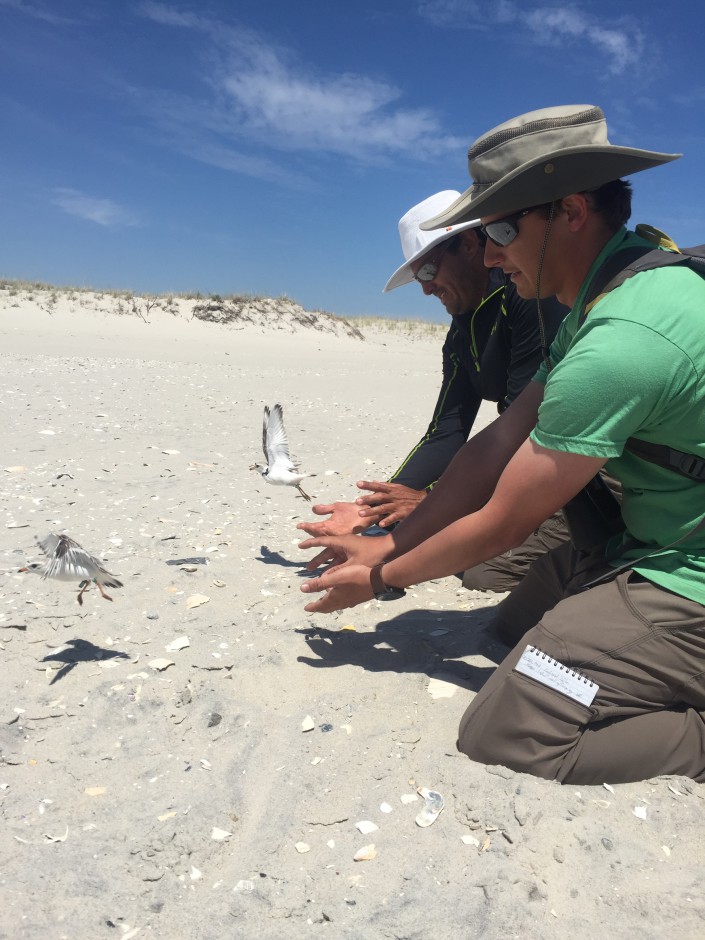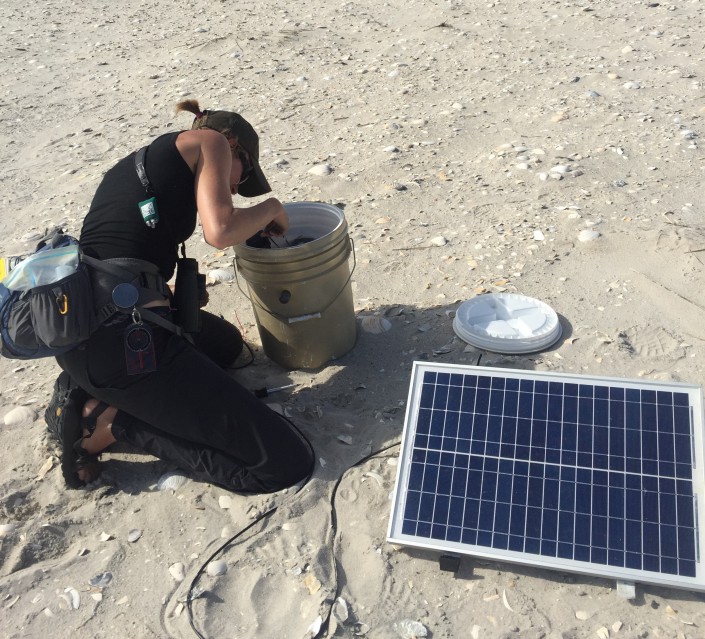Pondering the Plovers
Researching the Causes of Chick Loss in Piping Plovers
By: Emily Heiser, Biological Assistant

I often find myself contemplating the lives of Piping Plovers. What happened to that nest? Why did they choose that exact spot to lay their eggs? Why did those chicks disappear? Where will they go for the winter? As wildlife biologists and conservationists who spend hours and hours each summer watching them, we tend to question every aspect of the Piping Plover’s life cycle. These questions also push us to work harder and do more for this species, which is so imperiled throughout its range.
This summer, thanks to the extraordinary support of the US Fish and Wildlife Service, the New Jersey Division of Fish and Wildlife, and along with the blessings of Conserve Wildlife Foundations’s own Beach Nesting Bird Project Manager Todd Pover, the State University of New York College of Environmental Science and Forestry (SUNY-ESF) received the green light to proceed with a chick mortality study of Piping Plovers along New Jersey’s coast.
Funded by the National Fish and Wildlife Foundation, SUNY-ESF’s Jonathan Cohen and Michelle Stantial have teamed up once again to make some plover magic happen here in New Jersey. Having had the great privilege of working for this dynamic duo in the past, I am over the moon to be able to assist them once again.

The big question of this study is simple on the surface: what are the causes of chick mortality? The methods of finding those answers are much more complex. On April 15th, we kicked off another fantastic field season collecting data from Barnegat Light to Cape May. In order to determine the causes of chick loss we first need to locate nests, determine nest fate, track the adults, and then finally track the chicks. We hit the ground running and so far there are 26 active nests between all of our study sites! One of the most interesting parts of this study pertains to the cameras we are placing at a number of nests.
Our high tech plovers are now enjoying a 24/7 monitor that never bothers them, but is always watching. On more occasions than I can count, I have come across a nest that was lost in the past 10-24 hours.
We make our best guess as to what happened based on the evidence…Was it a flood? An avian predator? A mammalian predator? What happened?! It’s frustrating, but now we can know with certainty and we can learn much more about the threats Piping Plovers face on their breeding grounds.

Another important component of this project revolves around the banding and nano-tagging the adults. It is essential to the study that we are able to determine survival and movement of the adults. So far we have been able to band 24 adults, with 10 of those also receiving a transmitter. There are two telemetry towers between our study sites. These towers are able to pick up multiple radio-tagged birds and track of them day and night.
Interestingly, in a previous study developed by SUNY-ESF adult female Piping Plovers spent much of the evening away from the nest and leave the males to do all of the nocturnal incubating! The most advantageous part of these towers will, in theory, be able to tell us what happens to the chicks. Each chick will receive a tiny transmitter and as depressing as it may seem, those towers can tell us the speed and trajectory a chick was carried away from the site by a predator.
My vote was to give the chicks an iPhone and shoot me a text when they were in danger, but that doesn’t seem to be possible…yet.
I am not sure there will ever come a day when I am not pondering the lives of Piping Plovers, but I believe that science and research will continue to supply more answers. I believe that this particular study will contribute to a greater understanding of these birds, and on a personal level, I believe it will enable me to become a better steward and manager of all New Jersey’s beach nesting birds.
We look forward to bringing spectacular photos and updates whenever we can, so stayed tuned for more pondering of plovers!
Learn more:
- Conserve Wildlife Foundation’s Beach Nesting Bird Project
- Conserve Wildlife Foundation’s Online Field Guide: Piping Plover
Emily Heiser is the Biological Assistant for Conserve Wildlife Foundation of New Jersey.
Discover more from Conserve Wildlife Foundation of NJ
Subscribe to get the latest posts sent to your email.
Leave a Comment
I LOVE this project and am so excited to hear the results! I agree, tho, would be nice if they’d just shoot us a text. Since they are chicks and can’t read or wrire yet, they could just use emojis, lol. Great work, SUNY team!
Great post! Thank you for the work you are doing to help our plovers. It is so appreciated.
Comments are closed.